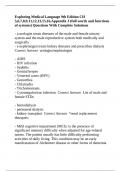Exploring Medical Language 9th Edition CH
5,6,7,8,9,11,12,13,15,16,Appendix J (full words and functions
of systems) Questions With Complete Solutions
- a urologist treats diseases of the male and female urinary
system and the male reproductive system both medically and
surgically
- a nephrologist treats kidney diseases and prescribes dialysis
Correct Answer urologist/nephrologist
- AIDS
- HIV infection
- Syphilis
- Genital herpes
- Venereal warts (HPV)
- Gonorrhea
- Chlamydia
- Trichomoniasis
- Cytomegalovirus infection Correct Answer List of male and
female STDs
- hemodialysis
- peritoneal dialysis
- kidney transplant Correct Answer *renal replacement
therapies:
- Mild cognitive impairment (MCI): is the presence of
significant memory difficulty when adjusted for age-related
norms. The patient usually has little difficulty performing
activities of daily living. This condition may be an early
manifestation of Alzheimer disease or other forms of dementia
,- Age-associated memory impairment: is when memory function
tends to decline with aging when compared with young adults.
This is not necessarily a forerunner of dementia
- delirium: is potentially reversible acute disturbances of
consciousness with impairment of cognition. A number of
conditions can cause delirium by interfering with brain
metabolism. Drugs, alcohol, systemic infections, head trauma,
hypoglycaemia, and electrolyte disturbances are common
examples
- pseudodementia: is a disorder resembling dementia but is not
caused by a brain disease. This can be found in mental illness,
such as major depression, and can be Correct Answer *types of
cognitive impairment
- Removes waste material from the body
- Regulates fluid volume
- Maintains electrolyte concentration in the body fluid
- assists in blood pressure regulation Correct Answer Function
of the urinary system:
-Cause: resistance of body cells to the action of insulin, which
may eventually lead to a decrease in insulin secretion
-Characteristics: slow onset, usually occurs in middle-aged or
elderly adults; most patients are obese
-Symptoms: fatigue, blurred vision, this, and hyperglycaemia;
may have neural or vascular complications
,-Treatment: diet, exercise, oral medication, and perhaps insulin
Correct Answer *Type 2 diabetes mellitus
-Cause: the beta cells of the pancreas that produce insulin are
destroyed and eventually no insulin is produced.
-Characteristics: abrupt onset, occurs primarily in childhood or
adolescence; patients are often thin
-Symptoms: polyuria, polydipsia, weight loss, hyperglycaemia,
acidosis, and ketosis
-Treatment: insulin injections and diet Correct Answer *Type 1
diabetes mellitus
(AKA nonalcoholic steatohepatitis) may occur in nonalcoholic
patients who are obese and/or suffer from type II diabetes
mellitus Correct Answer Nash syndrome
(any agent) producing malformations (in the developing
embryo). Teratogens include chemical agents such as drugs,
alcohol, viruses, x-rays, and environmental factors Correct
Answer teratogen
(any noninflammatory) disease of the retina (such as diabetic
retinopathy) Correct Answer retinopathy
(any) disease of the endocrine (system) Correct Answer
endocrinopathy
, (any) disease of the eye Correct Answer ophthalmopathy
(any) disease of the mind Correct Answer psychopathy
(fetus with a very) small head Correct Answer microcephalus
(graphic) record of hearing Correct Answer audiogram
(occurring) after a seizure or attack Correct Answer postictal
(occurring) before a seizure or attack Correct Answer preictal
(occurring) between seizures or attacks Correct Answer
interictal
(spontaneous) discharge of milk Correct Answer lactorrhea
1. Alzheimer disease - the most common type of dementia,
making up 60-80% of all cases. The disease, the cause of
neurodegenerative disorder characterized by diffuse brain
atrophy and the presence of senile plaques and neurofibrillary
tangles within the brain cortex. Women are affected more than
men, and the disease is slowly progressive and usually results in
profound dementia in 5-10 years
2. Vascular or multiple infarct dementia - affects approximately
10-20% of patients with dementia. It is secondary to
cerebrovascular disease and usually occurs in older patients





